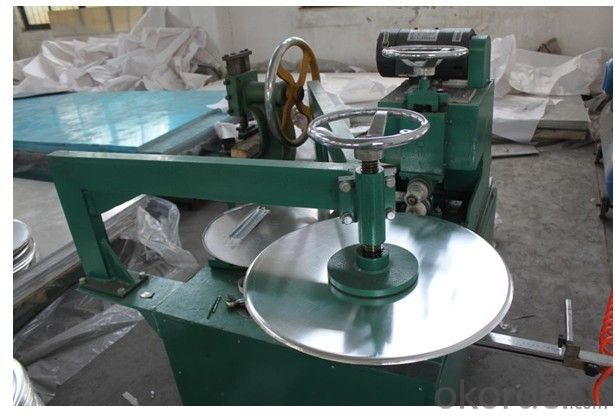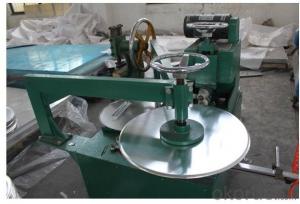Aluminum Circle Plate for Utensile Cookware
- Loading Port:
- Shanghai
- Payment Terms:
- TT OR LC
- Min Order Qty:
- 2 m.t.
- Supply Capability:
- 6000 m.t./month
OKorder Service Pledge
OKorder Financial Service
You Might Also Like
Item specifice
Aluminum Circle Plate for Utensile Cookware
Packaging & Delivery
| Packaging Details: | 25kg/carton-boxes(35*32*19CM) &Fumigation wooden-pallets (110*110*15cm) 20GP can loading 22 Ton,total 21 pallets,20 CBM. |
| Delivery Detail: | within 25 days |
Specifications
1).Excellent Surface Quality for lighting reflectors.
2).Excellent deep drawing and spinning quality.
3).Anodizing Quality
Aluminium circle/Aluminium discs/disks for cooking utensils Cookware
Aluminum disc Surface Finish: Bright & smooth surface, without flow lines, slightly oiled to avoid White rusting.Smooth,Brightly ,No Zone of Fracture ,No Scratched ,No oil Sludge
We enjoy a good reputation among our customers for our aluminum circle with high quality and competitive price, win high appreciation from our clients with the excellent workman-ship and professional ability. The quality matches with ISO 9001 quality management system.
It is equipped with 5 hot tandem rolling line, 4 cold mill production lines, 4 annealing surface machines and a complete finishing equipment.
Specification:
Alloy
Temper
Specification
Thickness
Diameter
1070,1050,3003,1100
O,H12,H14,H16
0.5-5.0mm
100-1200mm
Aluminum disc chemical Properties(WT.%)
Alloy
Si
Fe
Cu
Mn
Mg
Cr
Ni
Zn
Ca
V
Ti
Other
Min.A1
1050
0.25
0.4
0.05
0.05
0.05
-
-
0.05
-
0.05
0.03
0.03
99.5
1070
0.25
0.25
0.04
0.03
0.03
-
-
0.04
-
0.05
0.03
0.03
99.7
3003
0.6
0.7
0.05-0.2
1.0-1.5
-
-
-
0.1
-
-
-
0.15
96.95-96.75


- Q:What are the physical properties of aluminum?
- Aluminum possesses a silver-white appearance and is renowned for being a lightweight and malleable metal. It exhibits a relatively low melting point of 660.3 degrees Celsius (1220.5 degrees Fahrenheit) and a boiling point of 2519 degrees Celsius (4566 degrees Fahrenheit). With a density of 2.7 grams per cubic centimeter, it is approximately one-third as dense as steel. Furthermore, aluminum serves as a proficient conductor of both electricity and heat, thus finding widespread utilization in electrical transmission lines and heat sinks. Additionally, it showcases resistance to corrosion, due to the creation of a thin oxide layer on its surface, which renders it suitable for an array of applications across industries, including construction, automotive, aerospace, and packaging.
- Q:How does the aluminum plate manufacturer prevent the aluminum plate from scratching?
- Chaoyang aluminum manufacturers tell you that you can ask the manufacturer to cover the aluminum plate surface, to prevent aluminum plate scraping it!
- Q:What is the minimum bending radius for aluminum sheets?
- The minimum bending radius for aluminum sheets depends on several factors, including the thickness and alloy of the sheet, as well as the bending method being used. However, as a general guideline, the minimum bending radius for aluminum sheets is typically around 1.5 to 2 times the thickness of the sheet. For example, if you have a 1mm thick aluminum sheet, the minimum bending radius would be around 1.5 to 2mm. It is important to note that these values can vary, so it is always recommended to consult the specific material and bending guidelines provided by the manufacturer or a professional in the field to ensure optimal results.
- Q:What is the difference between aluminum plate AL1050 and AL1060?
- 1050 and 1060 belong to an aluminum plate, that is, pure aluminum plate, the difference is that the content of aluminum is different. 1050 aluminum content 99.95%, 1060 Aluminum Content 99.60%, material is very close, often can replace the use, the current use is more than 1060 Aluminum plate.
- Q:Can aluminum sheets be used for missile components?
- Indeed, missile components can indeed be made from aluminum sheets. Aluminum, an adaptable and light substance, boasts remarkable strength-to-weight ratio properties. These attributes render it a fitting option for a range of aerospace uses, including missile components. Aluminum sheets present benefits like resistance to corrosion, excellent thermal conductivity, and simplicity in fabrication. Moreover, aluminum exhibits the ability to endure extreme temperatures, making it a suitable choice for missile components that might encounter intense heat during flight. Nevertheless, it is crucial to take into account the specific requirements of the missile system and seek guidance from authorities in the field to ensure that aluminum sheets are suitable for the intended purpose.
- Q:Are 101 aluminum sheets suitable for heat sinks?
- Yes, 101 aluminum sheets are suitable for heat sinks.
- Q:How are aluminum sheets different from aluminum plates?
- Aluminum sheets and aluminum plates differ in terms of thickness. Sheets are typically thinner, usually less than 6 mm, while plates are thicker, typically more than 6 mm. Additionally, sheets are often used for lightweight applications such as packaging, whereas plates are commonly utilized for structural purposes or heavy-duty applications.
- Q:For my chem class that I just barely started taking, we're making bohr models. Even though my teacher explained it, I still dont get the concept of it all, like how the protons are lined up in their inner circle and the outer circles. I get everythign else about atoms except how they're actually made up lol. Maybe someone on here can explain it to me? I hope so because i have to make a model for it for friday.The element I'm asigned is aluminum btwYour help is greatly appreciated!
- People also rarely display the vast space between the orbitals and the nucleus. That would be a good one. If it is aluminum that you are showing, Why not make it out of aluminum? Hope this helps.
- Q:How many atoms are in a 2.80 cm* 2.80cm*2.80cm cube of aluminum?
- 2.8cm * 2.8cm * 2.8cm= 21.95 cm^3 is volume of Aluminum present Density of Al = 2.7g/cm^3 Convert volume of aluminum into grams of Aluminum, make sure your units cancel 21.95 cm^3 * (2.7g/1 cm^3) = 59.26 g Al Next, find how many moles of Al you have. MW Al = 27g/mol 59.26/27 = 2.19 moles Al Use Avogadro's number to find number of atoms of Al - 2.19 moles Al * (6.022x10^23 atoms/1 mol Al) = 1.32x10^24 atoms Al
- Q:What is the atomic number of aluminum?
- Aluminum's atomic number is 13.
1. Manufacturer Overview |
|
|---|---|
| Location | |
| Year Established | |
| Annual Output Value | |
| Main Markets | |
| Company Certifications | |
2. Manufacturer Certificates |
|
|---|---|
| a) Certification Name | |
| Range | |
| Reference | |
| Validity Period | |
3. Manufacturer Capability |
|
|---|---|
| a)Trade Capacity | |
| Nearest Port | |
| Export Percentage | |
| No.of Employees in Trade Department | |
| Language Spoken: | |
| b)Factory Information | |
| Factory Size: | |
| No. of Production Lines | |
| Contract Manufacturing | |
| Product Price Range | |
Send your message to us
Aluminum Circle Plate for Utensile Cookware
- Loading Port:
- Shanghai
- Payment Terms:
- TT OR LC
- Min Order Qty:
- 2 m.t.
- Supply Capability:
- 6000 m.t./month
OKorder Service Pledge
OKorder Financial Service
Similar products
New products
Hot products
Hot Searches
Related keywords





























